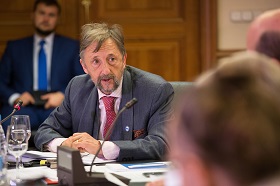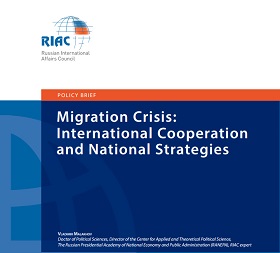On September 21–22, 2017, the Russian International Affairs Council holds a conference on migrant integration. Why has this problem gained such importance in contemporary Russia, which has only recently become an immigration destination? Why does it remain relevant for the EU, which has been welcoming migrants since the 1960s–1970s? What are the risks of insufficient integration, and why is migrant integration so important to economic development?
Even though researchers differ on what integration means, the term generally denotes integrating migrants into the host country’s society. At the socioeconomic level, this primarily means that migrants are integrated into the local labour market, find their own social niche and engage in social life. At the cultural level, it means that migrants adapt to the new linguistic environment and adjust to the local standards of conduct. At the legal and political levels, migrants get involved with the host country’s institutions and exercise their rights and obligations in accordance with their legal status.
Europe is growing increasingly concerned by the insufficient integration of migrants in terms of security. Virtually all the terrorist attacks staged in Europe over the past several years have been carried out by second- or third-generation immigrants. These are EU citizens whose ancestors moved to Europe many years ago, and in some cases were successful in finding their own niche in the labour market. But for whatever reason, the children or grandchildren of these immigrants started blowing up their fellow citizens, demonstrating a complete rejection of European values and that they do not identify with the host society. As a result, Europe has found itself split in two under pressure of incoming refugees from Africa and the Middle East. Voices advocating help for those who are fleeing war are increasingly eclipsed by popularity-seeking politicians demanding a cap on migration and auguring the onset of chaos and terror for Europe.
This securitization of migration is equally a feature of Russia. Natives of Central Asia were involved in virtually every underground terrorist cell, every terrorist attack staged or prevented in the country over the past few years. In many cases, these people had entered Russia as labour migrants. According to Alexander Bastrykin, who heads the Investigative Committee of the Russian Federation, “recruiters deliberately exploit the immigrant community to radicalize CIS citizens who have failed to adapt in Russia; they aim to set up so-called sleeper cells that could be used in terrorist attacks […]” It appears, however, that the policy of “stricter control over migration flows” promoted by the Investigative Committee is unlikely to solve the problem on its own. A “suspicious-looking” immigrant can be denied entry upon the request of the special services, but it would be impossible to “get inside the head” of an immigrant who is already living and working legally in the country. Terrorism cannot be beaten exclusively by introducing stricter control measures. One thing that makes the ideas promoted by radical Islamists and Islamic State so appealing is that the Muslim youth had an ungratified urge for identification and social integration. Radicals offer immigrants more than “employment”: they peddle a certain “fair world order” model. This model finds its adepts among those whose hopes for a better life in Russia, with its highly competitive labour market and fairly disintegrated society, have failed. Immigrants coming to Russia from Central Asia effectively become marginalized: having left a society in which they failed to carve out a suitable socioeconomic niche for themselves, they have not yet found a place in the host society either, which is actually often quite hostile to migrants. Marginalization and disintegration makes this kind of immigrants easy prey for recruiters. Law-enforcement agencies and special services can hardly counteract the contagious “fair state” virus and intervene in the identity-forming process: if an idea has its followers, it is unlikely to be stopped by merely arresting some recruiters. The experience gleaned from studies of “non-systemic” social networks, from the mafia and drug dealers to terrorists, indicates that a state relying mainly on law enforcers and special services in its fight against Islamization stands virtually no chance of conquering networked structures, which are more flexible, have no problems recruiting new members thanks to quickly spreading viral ideas, and rarely crumble if one or two of their leaders are eliminated.
Does all this mean that the chances of a host country preventing the radicalization of migrants are too slim? Probably not, given that the state has a broad range of social integration methods in its toolbox: the education system, the regulated labour market, legal protection mechanisms, the cultural environment and the everyday practices of social integration. If used wisely, these instruments might help rectify the situation. The system of education, including religious instruction, needs to be adjusted to the new reality: research indicates that recruiters most often succeed in indoctrinating young people who have a rather vague idea about Islamic traditions and the key canons of Islam. Such young people are offered distorted perceptions of religion, frequently those promoted by theologians in Saudi Arabia and other Middle Eastern countries. As for the labour market, it would be advisable to replicate some of the practices used in EU countries, which test every newly arrived immigrant to assess their level of education and professional competencies, run career enhancement programmes, and offer free language courses. Italy is achieving good results with its own system: it involves immigrants in such activities as restoring furniture and buildings, provides them with employment opportunities, including as tour guides for compatriot tourists, etc. The OECD is working to improve this programme: the organization reports that 27 per cent of highly qualified migrants are still unemployed, and 26 per cent of those employed are overqualified for their positions. What is important here is that the EU makes a point of analysing each immigrant's education level and competencies. This approach makes it possible to kill two birds with one stone: the immigrants get an opportunity to find their niche, and the host countries use additional personnel resources to develop their economies (it should be noted that the EU’s 2060 employable population is projected to shrink by 38 million by the year 2026). A number of reputable economists point out that EU states will report a modest economic growth for 2017 thanks to the labour market revival caused by the migrant influx 1. However, this scenario will only be possible if the host country manages its labour market wisely and establishes a personnel recruitment and training system that would prevent menial jobs going to overqualified candidates. Otherwise, immigrants might start looking for a job in the “fair” Islamic State.
1. Eurozone Economists’ Survey 2016: Refugees. How Will the Mass Arrival of Refugees Affect the Eurozone Economy? // Financial Times, January 27, 2015. URL: https://www.ft.com/content/8cab36e4-a4ee-11e5-97e1-a754d5d9538c






